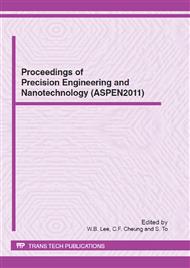p.19
p.25
p.30
p.36
p.42
p.48
p.54
p.60
p.66
Ultra Precision Machining of the Winston Cone Baffle for Space Observation Camera
Abstract:
The Winston cone baffle was developed for the space observation camera of the MIRIS (Multi-purpose Infrared Imaging System) which is the main payload of STSAT-3 (Science and Technology Satellite). The Winston cone baffle reduces the orbital heat load to the STSAT-3 and is thermally connected to the radiator to cool down. The jig and ultra precision machining jig was designed using a 3D modelling program and analyzed using a computer aided engineering program (ANSYS). The reasons for designing the jig for the baffle were to enhance the stability of the machining and improve the form accuracy of the baffle. The strength, weight and barycentre of the jig are investigated to find the optimized ultra precision machining conditions. To maintain the weight balance of the baffle at high speed rotation, there are lots of holes that can be inserted by heavier bolts. Vibration of the natural diamond bite tool is reduced by using thin copper pipe and urethane silicone. Using this bite tool, we could decrease patterns on the surface of the Winston cone baffle. The results of the simulation using ANSYS show that maximum deformation of the baffle is less than the tolerance limit. Surface roughness of the fabricated Winston cone baffle is machined with the jig and the machining tool is under 5 nm. The Winston cone baffle is plated with gold after being electroless plated with nickel. This baffle is applied to the flight model of the MIRIS.
Info:
Periodical:
Pages:
42-47
Citation:
Online since:
June 2012
Keywords:
Price:
Сopyright:
© 2012 Trans Tech Publications Ltd. All Rights Reserved
Share:
Citation:


